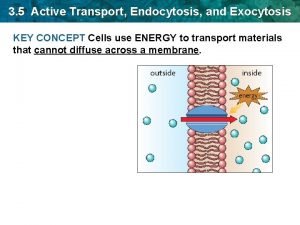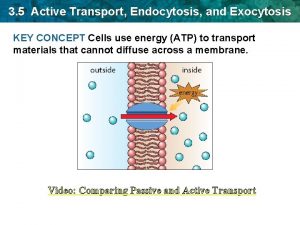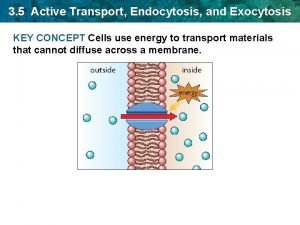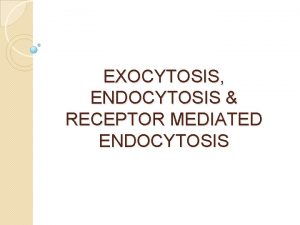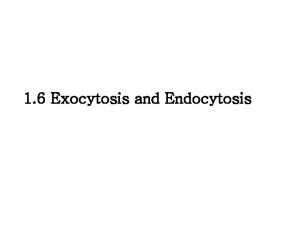3 5 Active Transport Endocytosis and Exocytosis KEY







- Slides: 7

3. 5 Active Transport, Endocytosis, and Exocytosis KEY CONCEPT Cells use ENERGY to transport materials that cannot diffuse across a membrane.

Active Transport Active transport requires energy input from a cell and enables a cell to move a substance against its concentration gradient, from a region of lower concentration to a region of higher concentration. • Active transport is powered by chemical energy (ATP). • Active transport occurs through transport protein pumps. • Cells use active transport to maintain homeostasis.

Endocytosis MAIN IDEA: A cell can import and export large materials or large amounts of material in vesicles during the processes of endocytosis and exocytosis. Energy is required! Endocytosis is the process of taking material into the cell such as liquids or fairly large molecules by engulfing (surrounding) them in a membrane.

Steps of Endocytosis During Endocytosis, the cell membrane folds inward and fuses together. This surrounds the substance in a pocket. The pocket pinches off inside of the cell, forming a vesicle. The vesicle fuses with a lysosome or similar vesicle. Then, enzymes break down the membrane AND the contents inside!

Phagocytosis is a type of endocytosis where the cell membrane engulfs large particles. • Phagocytosis actually means “cell eating. ” • It plays a key role in our immune systems. How? Some white blood cells in the human body are called macrophages. Their purpose is to help fight infection. They seek out foreign materials in the body, such as bacteria and engulf and destroy them!

Exocytosis • Exocytosis is the opposite of endocytosis. It is the release or expelling of substances out of a cell by the fusion of a vesicle WITH the membrane.

Steps of Exocytosis The cell forms a vesicle around material that needs to be expelled from the cell. The vesicle is transported to the cell membrane. The vesicle membrane fuses with the cell membrane and releases the contents from the cell.
